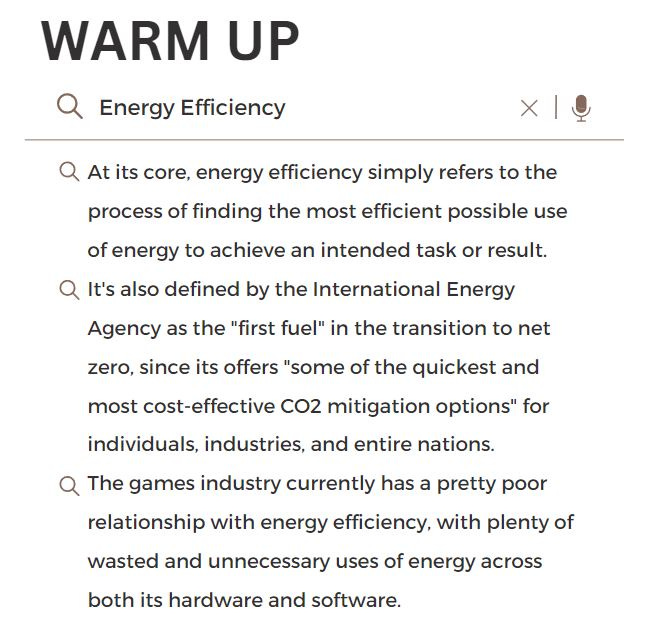"There is little necessity to deliver a 120 FPS menu"
Your latest digest of video game and climate change news from the past two weeks.
Welcome to the latest edition of Play Anthropocene!
Today is Tuesday, August 22nd, and we’re covering the latest developments in the world of video games and climate change. Happy reading!
Call of Duty follows its competitors’ lead with “Eco Mode” sneak attack
Call of Duty: Modern Warfare 2 and Warzone hit Season Five in its ongoing live service run earlier this month and, for most players, that means new maps, modes, weapons, and characters, such as Phillip Graves, the secondary antagonist from the game’s single-player campaign.
Oh, you thought he died in that tank you decisively blew up at the end of the story? Nah, he wasn’t in that tank, and he’s not going to elaborate any further on the matter, thank you very much. What a satisfying, well-earned, and totally believable plot twist!
Anyway… stupefying story niggles aside, hidden within the Season 5 patch notes are also details of an “Eco Mode” that developer Infinity Ward has added into the game. You can find the different options for Eco Mode in the graphics settings of the main menu, and here’s what they do, in IW’s own words…
Off: Same behaviour as all previous updates with no power savings.
Minimal (Default): Frame rate capped at 60hz and slight drop in 3D scene resolution for the Multiplayer and Warzone lobbies only. Yields an average power savings of 20%.
Full: Frame rate capped at 30hz and a more significant drop in 3D scene resolution for the Multiplayer and Warzone lobbies only. Yields average power savings of 50%.
First of all, props to Infinity Ward for making “Minimal” the default setting for all players as part of the update. The majority of players likely won’t actively seek out their settings to switch Eco Mode to “On”, and so by automatically doing the work for them, Infinity Ward is saving a lot of energy that would have otherwise been lost. It would have been nice for the studio to make a slightly bigger song and dance about the addition, though, as there’s likewise a good deal of people who would equally be willing to set the mode to “Full”, but currently have no idea that it’s even an option.
Of course, one potential reason behind Infinity Ward’s relative silence on the feature is that the studio doesn’t want too many players knowing about any intentionally set limitations on Call of Duty’s fidelity. This would correlate with the same maxim that Epic Games and 343 Industries have followed in drawing down the energy demands of Fortnite and Halo Infinite respectively, namely that boosting energy-efficiency at the expense of presentation is all well and good, but only if it can be done without players noticing the difference.
This approach is perhaps rooted in a fear of a potential blowback from a live service community who would kick up a fuss against any visual degradation to their favourite game, but this itself is based on the assumption that most players would be against such concessions in the first place. Instead, I would like to believe that most of this kind of hostility originates from a loud, but small corner of the internet, and that the rest of us are comfortable withstanding sensible downgrades to game fidelity in order to lower the carbon footprint of our dearest hobby.
In any case, I’ve ramped Warzone’s Eco Mode up to full blast on my PS5, and - hand to my heart - could not tell you that I noticed any visible difference to fidelity while sat in the Warzone lobbies. And trust me, I pretty much spend half of my weekday lunchtimes sat in those lobbies, so I’m very familiar with what they look like.
Xbox’s guide to making energy efficient games is a win for common sense
And what do you know? Less than a week after Call of Duty’s Eco Mode hits, Xbox publishes the first draft of its Energy Efficiency Essentials guidelines, which it describes as a “collection of essential suggestions for game developers who wish to manage their game's power consumption more responsibly without sacrificing gameplay fidelity”.
The company’s proposals are split into two categories: passive features and opt-in/opt-out features, with the former described as those which “lower the game's power consumption at opportune moments when gamers would not even realize […] and should ideally be imperceptible to the gamer.”
Detecting a theme here? Again, maintaining the illusion of max fidelity seems to be a priority for Xbox as much as the rest of the industry, despite the fact that, a little further down the guidelines, the company acknowledges both “internal and external research validates [that] players […] expect companies to strengthen their climate commitments; and are supportive of energy efficiency feature as options.”
“Options” is the optimal word here. Microsoft’s guidelines seem to suggest that, while it might be better to slip out passive features under the radar, players will be more welcoming of opt-in/opt-out features that give them choices over the energy-efficiency of their games, and so these needn’t be implemented as covertly. Again, Infinity Ward could have perhaps benefited from this advice just one week earlier, as pushing out its “Eco Mode” with a bit more song and dance could have led to a lot more people switching the feature onto “Full”.
Beyond this ongoing tension between energy-efficiency and perceived player satisfaction, the guidelines offer other interesting pieces of advice, including on the approach to menu design. I’m particularly fond of the hilariously dry assertion that “there is little necessity to deliver a 120 FPS menu”, and I’d imagine most of us are inclined to agree. The guidelines also suggest that developers “design menus as 2D backplates” to bring down energy demands; another common sense feature which I’d struggle to imagine anyone feeling particularly passionate about opposing. I like unique video game menus as much as the next player, but let’s be honest; we don’t need an audio-visual showcase every time we pause to take a bathroom break.
All in all, the document is an encouraging and impressive foundation for game standards moving forward, and exactly the kind of thing the industry has been needing for a long time. Would I look to see them evolve in their ambition and scope over time? Of course. Will the industry eventually be able to drop its irrational fear of potentially alerting the player to these drawdown plans? I sure hope so.
Cities Skylines 2 has a chance to showcase the perils and potential of urban living in climate crisis
I’ve been keeping a close eye on Cities Skylines 2 ever since it was first revealed by developer Colossal Order earlier this year, keen to see how climate science is being folded into this sequel’s design, especially given its promise to offer “the most realistic city builder ever”.
So far, I haven’t seen much information about the ways in which, say, rising temperatures or increased risks of natural disasters might be acknowledged in the game’s design, but the studio’s Feature Highlight on Skyline 2’s Electricity and Water systems (as seen above) does at least suggest this sequel will adopt a more nuanced approach to how it presents those two titular variables for players.
For one thing, instead of vague “electrical zones” that players used to power their cities in the first game, a fully functional electrical grid is now required for cities to bring electricity to the homes of their denizens. Meeting demand, managing bottlenecks, and delegating overload are new challenges you’ll need to accommodate in your quest to build a successful city, and then there’s the question of how to power those grids in the first place.
Colossal Order provides the option for both renewable sources of energy and traditional fossil fuel plants, such as coal, to juice up your grid, and while going for the latter will provide you with the most power, their pollution output is much higher. The manifestation of that output is generally telegraphed via complaints from citizens about air quality - an important consequence of burning fossil fuels, for sure - but I’d also like to see Colossal Order bring in a more global perspective here.
What if one barometer players needed to keep an eye was their cities’ net-zero commitments, and the responsibility they hold as a major urban settlement to be at the forefront of the transition to renewable energy? The challenges would require a lot of upfront investment in green energy, green spaces, and green jobs, but the rewards (other than the obvious ones) might be contextual bonuses like funding from supranational bodies, an enhanced global reputation that brings in more tourism and trade, and improved urban resilience against the impacts of climate change, therefore saving money in the long run.
Described as both a “cause and solution” to climate change (a Homeric a description as they come), cities are a critical leader in the pathway to a sustainable planetary future, and - as those often hit hardest by the effects of climate change - have a vested interest in stepping up to that plate. This is particularly relevant for the urban jungles of the Global North that Cities Skylines draws heavy inspiration from, as these cities hold much historic responsibility for fuelling the problem of climate change itself.
If Colossal Order’s upcoming title can work to gamify these complex dynamics of accountability, adaptation, and resilience, its ambitions to realistically emulate 21st century city management would only reach further heights. From what I’ve seen of the game so far, I’m not sure that’s going to be the case for Cities Skylines 2 at launch, but hey, as its predecessor confidently proved, there’s always room for expansion.
Enjoyed this newsletter? Subscribe or spread the word about Play Anthropocene to others who might be interested, and if you have any feedback or questions, feel free to get in touch with me at PlayAnthropocene@gmail.com
Find me on Twitter: @alexavard95







